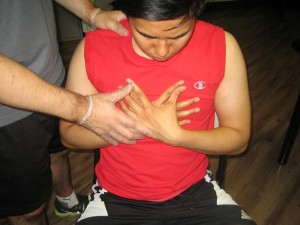The rib cage is comprised of 12 ribs with tendons and muscles in between every rib. If the individual engages in contact sports or sustained injury to the torso such as after a vehicular accident, he/she could be suffering from bruised ribs. It simply means that the tissues surrounding the ribs were damaged, but the bones are not cracked or fractured.
The symptoms of bruised ribs include abdominal or chest pain that worsens while sneezing, deep breathing or coughing forcefully. If the individual sustained bruised ribs, there are measures that can help minimize the pain while the body steadily recovers.

- Wrap the injured ribs with a compression bandage or binder that is similar to a fabric-based sleeve. Make sure that it mounts around the torso and delivers adequate support to the ribs. Take note that this can help hold the soft tissues in place and limit sudden movements that contributes to the pain. These supports are readily available in many drugstores. Just remember not to wrap the bandage too tight since it cuts off proper circulation.
- Apply an ice pack over the affected ribs. You can purchase an ice pack or create your own by placing ice cubes in a plastic bag and wrap the bag using a towel or cloth. Make sure that you will apply the ice pack on the affected area in 10-15 minute increments. The application of ice on the area helps reduce the inflammation and pain.
- Provide the individual with over-the-counter pain medications such as ibuprofen or acetaminophen. These medications work by reducing the swelling of the blood vessels as well as reduce the pain as the ribs start to heal. It is recommended to only use as directed to prevent damage to the lining of the stomach.
- If possible, movement must be limited especially lifting or twisting movements. Even though it can be frustrating to stay sedentary, it helps prevent further straining and stretching of the ribs that can worsen the injury. The individual can occasionally engage in exercises such as pointing and flexing the foot to maintain good circulation to the extremities while at rest.
- Try to increase the intake of fluid and fiber-rich foods such as fruits, vegetables and whole grains. It is important to note that constipation is a typical side effect of leading a sedentary lifestyle when recuperating from a bruised rib. It is vital to maintain a strong digestive system to reduce the abdominal pain that occurs along with bruised ribs.
Vital tips to bear in mind
In case the pain due to bruised ribs does not react to over-the-counter medications, the doctor might prescribe a stronger pain medication or recommend an anesthesia that is injected into the bruised area. Since the affected ribs can affect how the individual breathes, the injection might be required in some cases.
